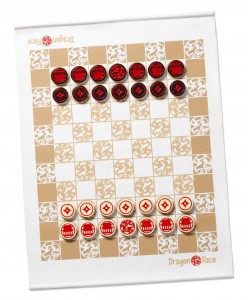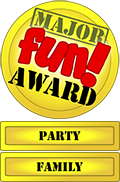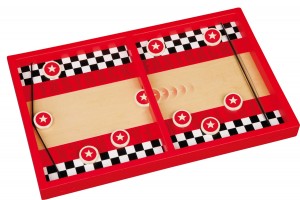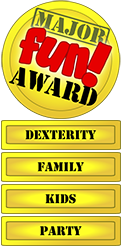Turns out to have been another great year for great games. Here’s our favorites:

Reverse Charades plays like the traditional game of charades but instead of one person acting and the rest of the team guessing, one person is guessing while the rest of the team is performing. That’s it. Team act. Individual guess. Reverse Charades. In Reverse Charades, no one is embarrassed, because everyone is acting silly together. And yes, there isa certain chaos. And yes, it’s the very kind of chaos [that] makes the fun major.
Party Gras is loud and fast and frustrating and MAJOR FUN!! Everyone is talking at the same time. You never know if you are being tricked into something or asked a legitimate question. You can’t lie (otherwise Talk it Out doesn’t work) and you can’t refuse to do an action but refusing to do silly things in a party game means that someone is unclear on the concept of a party game!!
 Trigger is Major Fun in a tiny round can. The referee asks a question. The other players race to slap the target with the correct hand. In order to answer these outrageously obtuse questions, players race to be the first to slap a foam target (think of a round drink coaster) with their left or right hand. Left hand for False and right hand for True. Right is right. Left is false. How hard can it be? Trouble is, when everyone is watching everyone else, it is really easy to mimic what someone else is about to do.
Trigger is Major Fun in a tiny round can. The referee asks a question. The other players race to slap the target with the correct hand. In order to answer these outrageously obtuse questions, players race to be the first to slap a foam target (think of a round drink coaster) with their left or right hand. Left hand for False and right hand for True. Right is right. Left is false. How hard can it be? Trouble is, when everyone is watching everyone else, it is really easy to mimic what someone else is about to do.
 Befuzzled gleefully directs players to perform the silliest actions in a split second. Your adrenaline is pumping, the decibels of laughter are crowding out all rational thought, and when the card is flipped, you know that you are supposed to flap your arms like a chicken but instead you moo like a cow and make binoculars with your fingers.
Befuzzled gleefully directs players to perform the silliest actions in a split second. Your adrenaline is pumping, the decibels of laughter are crowding out all rational thought, and when the card is flipped, you know that you are supposed to flap your arms like a chicken but instead you moo like a cow and make binoculars with your fingers.
 Shake-n-Take you have a card with 70 aliens. You must be the first to circle them all. You roll a die to find out which shape to circle and all the while your neighbor is frantically shaking another die until an alien head pops up. When the alien appears, your neighbor snatches the marker from your hand without so much as a “Thanks for the probe!” and starts to circle his or her aliens. For all the adrenaline junkies in my social cadre, there is no better fix than a game that boils down to circling pictures on a dry-erase board.
Shake-n-Take you have a card with 70 aliens. You must be the first to circle them all. You roll a die to find out which shape to circle and all the while your neighbor is frantically shaking another die until an alien head pops up. When the alien appears, your neighbor snatches the marker from your hand without so much as a “Thanks for the probe!” and starts to circle his or her aliens. For all the adrenaline junkies in my social cadre, there is no better fix than a game that boils down to circling pictures on a dry-erase board.
 Anomia is a game. According to Medicine.net, anomia is “a problem with word finding. Impaired recall of words with no impairment of comprehension or the capacity to repeat the words.” After 20 minutes of playing the game, I can personally confirm both definitions. It happened to me, my actual self. There came a time when all I had to do was name a guitarist. Any guitarist. Before another player was able to name a fashion designer. Spurred, thus, by spirit of competition, I said, with seemingly total assurance, “Jose Guitaro.” That’s what I said. Honestly. Jose Guitaro. Struck down by anomia while in the prime of playfulness.
Anomia is a game. According to Medicine.net, anomia is “a problem with word finding. Impaired recall of words with no impairment of comprehension or the capacity to repeat the words.” After 20 minutes of playing the game, I can personally confirm both definitions. It happened to me, my actual self. There came a time when all I had to do was name a guitarist. Any guitarist. Before another player was able to name a fashion designer. Spurred, thus, by spirit of competition, I said, with seemingly total assurance, “Jose Guitaro.” That’s what I said. Honestly. Jose Guitaro. Struck down by anomia while in the prime of playfulness.
 Ligretto and Dutch Blitz are both variations of Spit, and/or Speed, and perhaps even of Nertz, and in both cases the dedicated decks of cards make for an evening of deep, multi-player engagement. You place 4 cards in a row, face-up, next to the stack. The rest of your cards remain in your hand. If any of the cards in your row is a One, you can immediately play it to the table, and use one card from your stock to replace it. If any player has already played a One, and you have a Two of the same suit, you can play your two onto that player’s One. And so on, and so on, with evermore passionate intensity, until someone, having exhausted all her stock, screams “Ligretto” (best when the “r” of Ligrrrretto is rolled victoriously) or “Blitz” (with a blitzfully Germanic emphasis).
Ligretto and Dutch Blitz are both variations of Spit, and/or Speed, and perhaps even of Nertz, and in both cases the dedicated decks of cards make for an evening of deep, multi-player engagement. You place 4 cards in a row, face-up, next to the stack. The rest of your cards remain in your hand. If any of the cards in your row is a One, you can immediately play it to the table, and use one card from your stock to replace it. If any player has already played a One, and you have a Two of the same suit, you can play your two onto that player’s One. And so on, and so on, with evermore passionate intensity, until someone, having exhausted all her stock, screams “Ligretto” (best when the “r” of Ligrrrretto is rolled victoriously) or “Blitz” (with a blitzfully Germanic emphasis).
 Dragon Face is an elegant, robust strategy game, and although it is not laugh-a-nano-second fun like many of our Major Fun party games, it is deeply engaging in the way that only the best strategy games can be. This is fun for the chess set, and for those of you who have not succumbed to that particular addiction, Dragon Face may be your gateway drug.
Dragon Face is an elegant, robust strategy game, and although it is not laugh-a-nano-second fun like many of our Major Fun party games, it is deeply engaging in the way that only the best strategy games can be. This is fun for the chess set, and for those of you who have not succumbed to that particular addiction, Dragon Face may be your gateway drug.
 Pajaggle – is a precision made, laser-cut, acrylic puzzle/game. The pieces look a little like gears – very fine-toothed gears, some round-toothed, some very, very pointy. Some larger, some smaller, some with other pieces inside. There are a total of 61 pieces, no two of which are alike. The challenge – fit the pieces into their corresponding sockets. Which reminds you, correctly but vaguely, of that round-peg, square-hole thing.
Pajaggle – is a precision made, laser-cut, acrylic puzzle/game. The pieces look a little like gears – very fine-toothed gears, some round-toothed, some very, very pointy. Some larger, some smaller, some with other pieces inside. There are a total of 61 pieces, no two of which are alike. The challenge – fit the pieces into their corresponding sockets. Which reminds you, correctly but vaguely, of that round-peg, square-hole thing.
 Fastrack looks as attractive as it plays. The race-flag checkerboard and red colors accentuate the experience of speed. The elastic bands have enough elasticity so that you can shoot your disks with significant twang, and, if you shoot a disk just right, it can bounce back and forth across the board several many, delightworthy times. The board and disks are scaled perfectly so that you get the same delightful action you might get from a larger version, yet the game itself is just the right size to carry with you effortlessly everywhere. The twang often leads to many satisfying bangs as the disks carom off the wooden divider and the wooden sides of the wooden board. It is a skill game. And you can get better. And that’s all you need to know.
Fastrack looks as attractive as it plays. The race-flag checkerboard and red colors accentuate the experience of speed. The elastic bands have enough elasticity so that you can shoot your disks with significant twang, and, if you shoot a disk just right, it can bounce back and forth across the board several many, delightworthy times. The board and disks are scaled perfectly so that you get the same delightful action you might get from a larger version, yet the game itself is just the right size to carry with you effortlessly everywhere. The twang often leads to many satisfying bangs as the disks carom off the wooden divider and the wooden sides of the wooden board. It is a skill game. And you can get better. And that’s all you need to know.








 There are six kinds of missions—six ways to take beads from another player. In brief the missions are:
There are six kinds of missions—six ways to take beads from another player. In brief the missions are:







